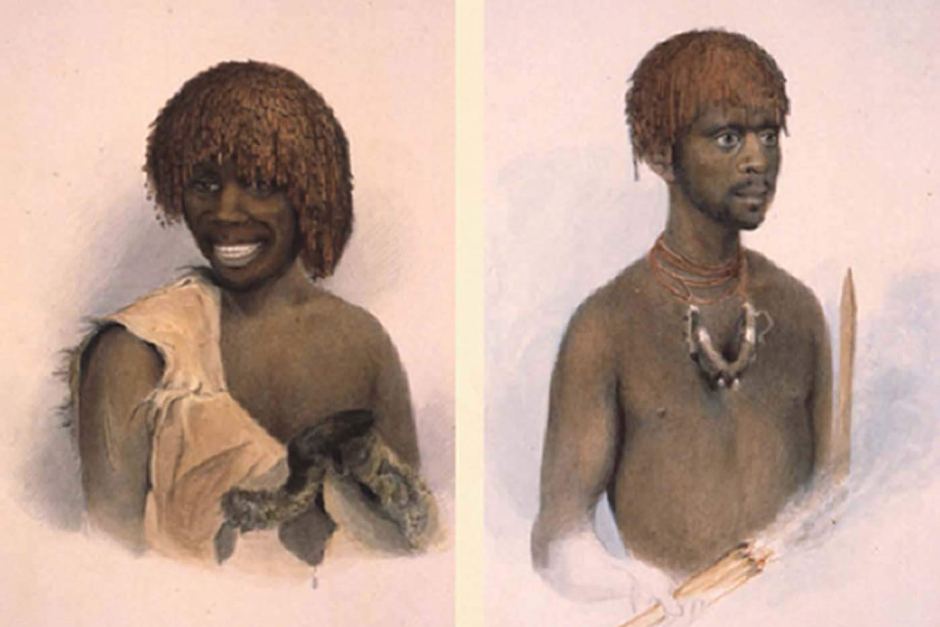tunnerminnerwait and maulboyhenner
 Tunnerminnerwait (left) and Maulboyheenner (right). Supplied: City of Melbourne
Tunnerminnerwait (left) and Maulboyheenner (right). Supplied: City of Melbourne
In 1841, seven years after the colonial occupation of the Port Phillip District began, two Aboriginal men from Van Diemen’s Land (Tasmania), were convicted of the murder of two whale-hunters in the Western Port area. On 20 January 1842 they became the first people hanged in Melbourne. There are many events and stories connected to the hanging of these two men, Tunnerminnerwait and Maulboyheenner. Firstly, the men’s stories are very important in their own right. So too are the stories of the women who were tried with them, Truganini, Planobeena and Pyterruner. The stories of these five Aboriginal people from Tasmania offer vital insights into the very significant past, present and future of Melbourne and Victoria. They are also a window into the complex colonial history of Tasmania. (Tunnerminnerwait and Maulboyheenner: The involvement of Aboriginal people from Tasmania in key events of early Melbourne Clare Land 2014)
http://www.auswhn.org.au/blog/maulboyheenner-tunnerminnerwait/
Tunnerminnerwait
Tunnerminnerwait was born on Robbins Island and his people were the Parperloihener from the North West nation. He was called ‘Jack of Cape Grim’ is because he worked in that part of the country for the VDL Company.
Maulboyheenner
Maulboyheenner was from around Tebrakunna Country, and his people were the Pairrebeenne or Trawlwoolway in the North East nation.
Both Tunnerminnerwait and Maulboyheenner were taken to Melbourne in 1839 by George Augustus Robinson, the 'Protector of Aborigines'.
Along with three Tasmanian Aboriginal women – Truganini, Pyterruner and Planobeena they waged a guerilla campaign, robbing and clashing with settlers from Dandenong to South Gippsland.
They were portrayed as bloodthirsty outlaws, but some scholars today attribute their actions to payback for years of atrocities against Aborigines or to self-defence in a clash with the whalers.
In 1842 Tunnerminnerwait and Maulboyheenner were the first men executed in Victoria.
Since 2004 the Tunnerminnerwait and Maulboyheenner Commemoration Committee has worked towards the building of a monument in Melbourne to mark this event.
The Melbourne City Council funded the building of a monument at their execution site, at the corner of Victoria St and Franklin St, opposite the Old Melbourne Gaol, in September 2016. This was the first monument to the Frontier Wars built in a major city in this country.
Reconciliation between indigenous and non-indigenous Australians is based on the recognition tens of thousands of Aboriginal and Torres Strait Islander men, women and children died as a result of colonisation in this land.
On the 20th January, Aboriginal and Torres Strait Islander Freedom Fighters Day, the Tunnerminnerwait and Maulboyheenner Commemoration Committee holds a public ceremony to honour the men, women and children killed during the colonisation for protecting their lands, their families, their culture and a way of life they had practised for over 40,000 years.
The Commemoration Committee believes participation in the annual ceremony will support reconciliation between indigenous and non-indigenous Australians.
Monument to Aboriginals' 1842 execution 'first step' to recognising brutal past https://www.theage.com.au/national/victoria/monument-to-aboriginals-1842-execution-first-step-to-recognising-brutal-past-20160911-grdvbx.html



